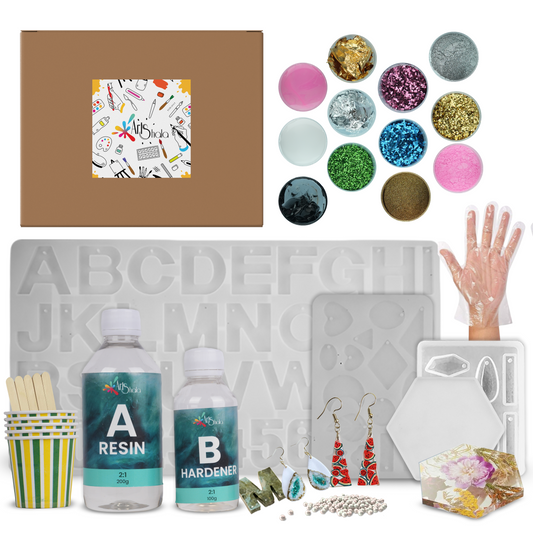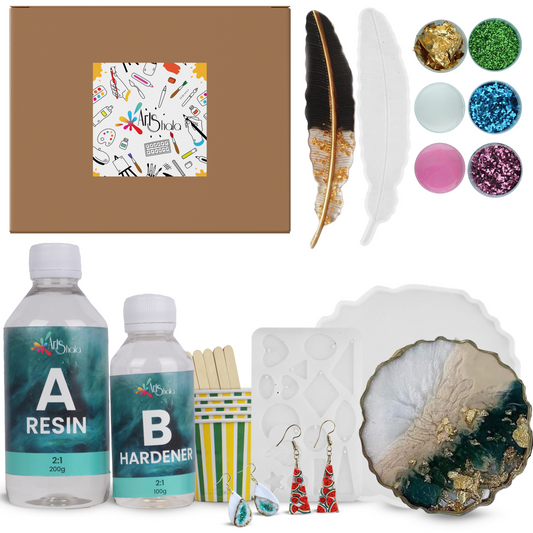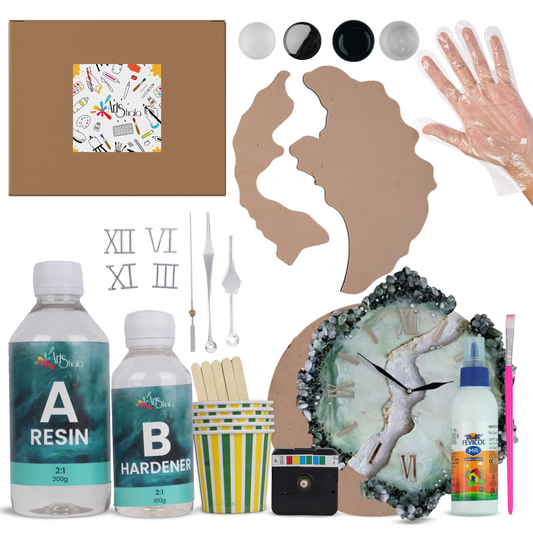Painting with Acrylics: A Beginner's Step-by-Step Guide
Acrylic painting is a creative medium that allows artists to explore creativity easily. It's fast-drying properties and vibrant colours make it an excellent choice for beginners. Learning its fundamental techniques is crucial, providing a great foundation for your artistic journey.
Consider joining an acrylic painting workshop to gain hands-on experience and connect with fellow artists. These workshops offer valuable insights and guidance, helping you navigate the initial challenges. In this blog, we will take you through the essential steps in painting with acrylics, making it easier for you to start. So, let's get right into it!
Understanding Acrylic Paints
Acrylic paints are a perfect choice for beginners due to their versatility and ease of use. Here are the key types and benefits:
Types of Acrylic Paints
- Student Grade: Affordable and great for practice; they offer decent pigmentation but may lack the richness of professional-grade paints.
- Professional Grade: Higher pigment concentration, providing vibrant colours and better light fastness. Ideal for serious artists looking to invest in quality.
- Heavy Body: Thick buttery texture, perfect for creating rich impasto effects.
- Fluid Acrylics: Thinner consistency allows for smooth application and is excellent for detailed work.
Advantages of Using Acrylic Paint
- Fast drying time enables quick layering and adjustments.
- Water-soluble when wet, making cleanup easy with soap and water.
- A wide range of colours can be mixed to create custom shades.
Essential Painting Supplies for Acrylics
Investing in a good set of materials will pay off as you develop your acrylic painting skills. Selecting the right tools empowers you to express creativity effectively while enjoying the learning process. Each brush or surface type opens up new possibilities for your artwork, encouraging experimentation and discovering personal style.
Brushes
Choosing the right acrylic paint brushes is crucial for creating the desired results in your artwork. Different brush types offer unique effects and techniques, making them suitable for various painting styles. Here are some common types of brushes used in acrylic painting:
- Flat Brushes: These have a rectangular shape and are ideal for broad strokes and filling large areas. They can create sharp edges and are great for blending colours.
- Round Brushes: With a pointed tip, round brushes are versatile tools for detail work, fine lines, and intricate designs. They come in various sizes, allowing artists to switch between bold strokes and delicate details.
- Filbert Brushes: This hybrid brush has a flat shape with a rounded edge, perfect for blending and softening lines. Filbert brushes combine the benefits of both flat and round brushes.
Understanding brush sizes and shapes enhances your control over the painting process. Brush sizes typically range from small (size 0) to large (size 12 or more). Smaller brushes allow for precision, while larger brushes help cover broader areas quickly.
Surfaces
Choosing the right surface is essential for successful acrylic painting. Different surfaces can influence texture and finish. Here are some standard options:
- Canvas: The most popular choice, available in stretched or loose forms. It provides a textured feel that works well with acrylics.
- Wood offers a smooth surface that can be primed for better paint adhesion. It is ideal for more controlled applications.
- Paper: Specially designed acrylic paper offers a lighter-weight option for quick studies or practice.
Preparing Your Chosen Surface
- Apply a layer of gesso for canvas to enhance paint adherence and longevity.
- When using wood, sand the surface lightly and apply gesso to create an ideal base.
- For paper, ensure it's thick enough to handle water without buckling.
Other Materials and Tools
Exploring various materials can elevate your acrylic painting experience. Here are some essential tools to consider:
- Palette Knives: These versatile tools allow for unique texture and layering effects. Use them to mix colours or apply paint in a more abstract style.
- Other Unconventional Tools: Consider using sponges, rags, or fingers. Each tool can create different textures and styles, adding depth to your artwork.
- Suitable Palette: A good palette with fast-drying acrylics is crucial. Choose a stay-wet palette or a traditional one made of glass or plastic. This helps keep your paints workable longer.
- Mixing Mediums: Incorporate mediums to extend drying time or change the paint's consistency. Products like retarders slow down drying, while gels can thicken the paint for more texture.
How to Paint with Acrylics for Beginners?
Incorporating the following guide will elevate your art as you explore the steps to paint with acrylics, providing a solid foundation for future projects in this acrylic painting tutorial for beginners:
Step 1: Choosing Your Subject and Composing It
Starting with the right subject can make a big difference in your acrylic painting journey. Here are some beginner-friendly options:
- Still Lifes: Simple arrangements of objects like fruits, flowers, or everyday items allow focus on basic shapes and colours.
- Landscapes: Capturing nature’s beauty can help you explore colour blending and depth.
- Abstracts: Experimenting without a defined subject can boost creativity and confidence.
Once you've chosen your subject, consider the principles of composition. Composition is about arranging elements in your artwork to create balance and interest. Here are some key concepts:
- Rule of Thirds: Imagine dividing your canvas into a grid of nine equal parts. Place essential elements along these lines or at their intersections for a more dynamic look.
- Focal Point: Decide what part of your painting should first draw the viewer’s eye. This could be an object or a specific area. Use size, colour contrast, or detail to emphasise it.
- Balance and Harmony: Strive for visual balance by distributing elements evenly across the canvas. This doesn’t mean everything must be symmetrical; asymmetrical balance can be just as effective.
Step 2: Preliminary Drawing and Sketching
Sketching is an important part of planning your acrylic artwork. It allows you to outline your composition before you start painting. Here are some essential techniques for beginners:
- Light Sketching: Use a soft pencil or charcoal to create a light outline of your subject. This approach allows for easy adjustments as you refine your composition.
- Acrylic Sketching: You can also use diluted acrylic paint for sketching. This method helps familiarise you with the medium while providing a base for your work.
- Proportions and Shapes: Focus on capturing the basic shapes and proportions of your subject. This foundation will guide you as you add details later.
Improving your drawing skills enhances your ability to compose effective acrylic paintings. With practice, these preliminary steps can lead to more confident and successful artwork, setting the stage for the next phase of your creative journey.
Step 3: Applying a Coloured Background
Creating depth and atmosphere in your artwork begins with the background. A coloured background wash can unify your painting and provide a solid foundation for your subject. Here are some steps to effectively apply a coloured background:
- Choose Your Colour: Select a shade that complements your main subject. For instance, if you're painting a vibrant flower, a muted green or soft blue might enhance its brightness.
- Dilute Your Paint: Mix your chosen acrylic colour with water for a translucent wash. This technique allows the underlying colours to interact, adding richness.
- Apply Evenly: Use a large or foam brush to apply the wash across your canvas. Work quickly to avoid uneven patches as acrylics dry fast.
Step 4: Applying Colours and Building Layers
Creating form and depth is crucial in acrylic painting. Layering techniques help achieve this effect. Here’s how to apply colours effectively:
- Start Light: Begin with lighter colours, gradually adding darker shades. This approach keeps your artwork vibrant.
- Thin Layers: Mix your paint with water for a transparent effect. Applying thin layers allows underlying colours to shine, enhancing the overall look.
- Allow Drying Time: Wait for each layer to dry before applying the next one. This maintains clarity and prevents colours from blending together.
- Avoid Using White: Instead of using white to lighten colours, use water for a more transparent effect. This keeps your colour palette rich and fresh.
Step 5: Adding Details and Highlights
Enhancing your artwork involves paying close attention to small details and highlights. This step allows you to bring your acrylic painting to life. Consider the following techniques:
- Focus on Light: Identify the light source in your composition. Use lighter shades of your base colours to highlight surfaces that catch the light.
- Layering for Depth: Apply thin layers of paint to build up textures. This technique can enrich areas like water, foliage, or fabric.
- Fine Brushes: Switch to smaller brushes for detailing. Round or liner brushes work great for intricate designs, outlines, or tiny features.
- Patience is Key: Allow each layer of paint to dry before adding more details. This ensures clarity and prevents muddiness.
Conclusion
Starting your journey as a beginner painter in acrylics can be a rewarding experience. Remember, every artist begins somewhere. Embrace the learning process and allow yourself to explore different techniques. Practice consistently, experiment with colours and styles, and don't fear mistakes; they often lead to unexpected creativity.
For those eager to improve their skills, Contact Us on Arts Shala. Engage in workshops designed for artists like you, where you can gain hands-on experience and helpful insights from experienced instructors. Remember, practice is key. The more you paint, the more you discover your unique style and techniques. So grab your brushes, explore the versatility of acrylics, and let your creativity flow!












